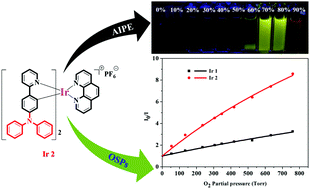A diphenylamino-substituted cationic cyclometalated Ir(iii) complex: its aggregation-induced phosphorescent emission and oxygen sensing properties†
Abstract
A cationic cyclometalated Ir(III) complex, Ir2, with aggregation-induced phosphorescent emission (AIPE) has been prepared and fully characterized. The effects of the diphenylamino (DPA) group on the photophysical properties, redox properties and oxygen sensing behaviors of the Ir(III) complex were investigated systematically, and compared with non-DPA-substituted complex Ir1. The results show that the introduction of an electron-donating DPA group at the 4-position on the phenyl ring of the cyclometalating ligand affects the HOMO levels of the corresponding Ir(III) complex significantly, resulting in a marked decrease in the energy gap. DPA-substituted Ir2 demonstrates obvious aggregation-induced phosphorescent emission, while non-DPA-substituted Ir1 is AIPE-inert. The phosphorescence oxygen sensing properties of both complexes were studied in polymer films, and fast response time and excellent operational stability were observed. Two-site model fitting results indicate that Ir2 exhibits higher sensitivity to O2 than that of Ir1. The DPA-substituted cationic cyclometalated Ir(III) complex is a potential candidate for efficient luminescent oxygen sensing.

- This article is part of the themed collection: Recent Progress on Aggregation-Induced Emission


 Please wait while we load your content...
Please wait while we load your content...